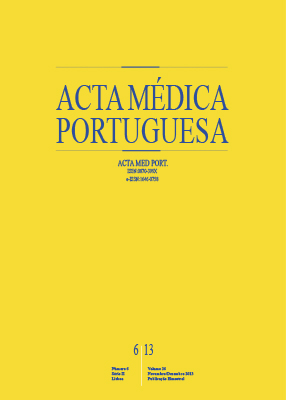What Factors Determine the Levels of Physical Activity after Cardiac Rehabilitation Program?
DOI:
https://doi.org/10.20344/amp.1742Abstract
Introduction: The Cardiac Rehabilitation Programs have gained tremendous importance in the prevention of cardiovascular disease and it’s a challenge to ensure the practice of regular exercise during and after the supervised program. The aim of this study was to determine the factors that influence the physical activity habits at 12 months after the Cardiac Rehabilitation Program.Material and Methods: Prospective study, including 580 patients with ischemic heart disease who were consecutively oriented for Cardiac Rehabilitation Program at Cardiovascular Prevention and Rehabilitation Unit of Centro Hospitalar do Porto, between January 2008 and June 2011. Physical activity levels were measured with International Physical Activity Questionnaire which was calculated at the beginning of the program, 3 and 12 months later. The following variables were chosen and tested as potential determinants of physical activity habits of 12 months after program: age; sex; modifiable risk factors; functional capacity (achieved in treadmill stress test); laboratory analysis (HbA1c, lipid profile, C-Reactive Protein and Brain Natriuretic Peptide). A linear regression analysis was carried to identify the significant determinants and to find the best model adjustment.
Results: Advanced age, female gender, functional capacity and low levels of physical activity prior to the Cardiac Rehabilitation Program, as well as a weak evolution of the International Physical Activity Questionnaire during the program were the best univariable predictors of a less favourable evolution of the International Physical Activity Questionnaire during 12 months of follow-up. A multivariable linear regression analysis showed that the best explanatory model included age, gender and evolution of the International Physical Activity Questionnaire during the supervised program (R2 Adj. = 0.318; f = 60.62, p < 0.001).
Conclusion: The identification of certain subgroups of patients with lower tendency toward physical activity is beneficial to enable timely and individualized strategies to maximize the therapeutic and preventive potential of the Cardiac Rehabilitation Programs.
Downloads
Downloads
Published
How to Cite
Issue
Section
License
All the articles published in the AMP are open access and comply with the requirements of funding agencies or academic institutions. The AMP is governed by the terms of the Creative Commons ‘Attribution – Non-Commercial Use - (CC-BY-NC)’ license, regarding the use by third parties.
It is the author’s responsibility to obtain approval for the reproduction of figures, tables, etc. from other publications.
Upon acceptance of an article for publication, the authors will be asked to complete the ICMJE “Copyright Liability and Copyright Sharing Statement “(http://www.actamedicaportuguesa.com/info/AMP-NormasPublicacao.pdf) and the “Declaration of Potential Conflicts of Interest” (http:// www.icmje.org/conflicts-of-interest). An e-mail will be sent to the corresponding author to acknowledge receipt of the manuscript.
After publication, the authors are authorised to make their articles available in repositories of their institutions of origin, as long as they always mention where they were published and according to the Creative Commons license.









